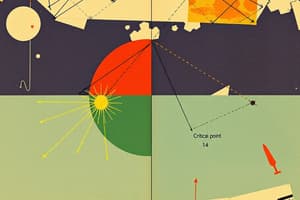Podcast
Questions and Answers
Why do animals live in different kinds of homes?
Why do animals live in different kinds of homes?
- To protect themselves and their young, and adapt to their environment. (correct)
- To compete with each other for better living places.
- Because they are assigned homes by humans.
- Because some animals prefer specific colors in their homes.
What is the primary function of a bird's nest?
What is the primary function of a bird's nest?
- To attract other birds for social interaction.
- To store food for the winter.
- To provide a safe place to lay eggs and raise young. (correct)
- To serve as a feeding station.
Which of the following best describes a burrow as a home for a rabbit?
Which of the following best describes a burrow as a home for a rabbit?
- A hole or tunnel dug in the ground for shelter and protection. (correct)
- A hollow space in a tree.
- An above-ground structure made of twigs and leaves.
- An open space with a fence around it.
How does a kennel primarily benefit a dog?
How does a kennel primarily benefit a dog?
Why might a farmer keep a cow in a barn?
Why might a farmer keep a cow in a barn?
Considering the homes of animals shown, what do they have in common?
Considering the homes of animals shown, what do they have in common?
Which of the following factors primarily influences the type of home an animal chooses or builds?
Which of the following factors primarily influences the type of home an animal chooses or builds?
How does living in a safe home contribute to an animal's survival?
How does living in a safe home contribute to an animal's survival?
What might happen to a bird if its nest is destroyed?
What might happen to a bird if its nest is destroyed?
How do animals demonstrate adaptation through their choice of homes?
How do animals demonstrate adaptation through their choice of homes?
Given that animals eat different kinds of things, how might their diet affect where they choose to live?
Given that animals eat different kinds of things, how might their diet affect where they choose to live?
If a rabbit's burrow collapses, what immediate threat does the rabbit face?
If a rabbit's burrow collapses, what immediate threat does the rabbit face?
In what way can humans help provide better homes for animals?
In what way can humans help provide better homes for animals?
Why is it important for animals to have access to different kinds of homes?
Why is it important for animals to have access to different kinds of homes?
How can understanding where animals live help us protect them?
How can understanding where animals live help us protect them?
How can the study of animal homes teach us about the environment?
How can the study of animal homes teach us about the environment?
Why do some animals build their homes while others find theirs?
Why do some animals build their homes while others find theirs?
If you were to design a new animal home, what would be the most important consideration?
If you were to design a new animal home, what would be the most important consideration?
What role does community play in the housing of some animal species?
What role does community play in the housing of some animal species?
Besides safety, what other needs might an animal home fulfill?
Besides safety, what other needs might an animal home fulfill?
Flashcards
Where do animals live?
Where do animals live?
Animals exist in various sizes and reside all over the world.
Animal Homes
Animal Homes
Animals reside in various kinds of shelters.
What is a nest?
What is a nest?
A bird's home.
What is a burrow?
What is a burrow?
Signup and view all the flashcards
What is a kennel?
What is a kennel?
Signup and view all the flashcards
Study Notes
Phase Diagrams
- Phase diagrams are useful for understanding the relationships between phases in a material system.
Phase Rule
- The phase rule defines the number of degrees of freedom (F) in a system.
- Degrees of freedom refer to the number of independent variables needed to define the system's state.
- The formula for calculating the number of degrees of freedom is F = C - P + 2.
- C represents the number of components.
- P represents the number of phases.
Cooling Curves
Pure Metal
- The melting point is indicated by point a on the diagram.
- The metal solidifies at a constant temperature between points b and c.
- The metal cools as a solid between points c and d.
Solid Solution Alloy
- Solid solution alloys freeze over a range of temperatures between points b and c.
- These alloys lack a sharp melting point.
Example 1: The Cu-Ni System
- This system has two components (C = 2): Copper (Cu) and Nickel (Ni).
- This system has two phases (P = 2): Liquid and Solid.
- Therefore, F = 2 - 2 + 2 = 2.
- Defining this system requires specifying two intensive variables, such as temperature and composition.
- If only one variable, such as composition, is defined, then F = 2 - 2 + 1 = 1.
- Specifying the temperature can then define the system.
- Liquidus line: the line above which only liquid exists.
- Solidus line: the line below which only solid exists.
Lever Rule
- The lever rule determines the composition of liquid and solid phases at a given temperature.
- The percentage of solid is calculated as: % solid = ((c-b)/(a-b)) * 100.
- The percentage of liquid is calculated as: % liquid = ((a-c)/(a-b)) * 100.
- 'a' represents the overall composition of the alloy.
- 'b' represents the composition of the solid phase.
- 'c' represents the composition of the liquid phase.
Example 2: The Iron-Carbon System
- This system is relevant to steel production.
- This system consists of two components (C = 2): Fe and $Fe_3C$.
- This system consists of two phases (P = 2): Liquid and Solid.
- Therefore, F = 2 - 2 + 2 = 2.
- Defining the system requires specifying two intensive variables, such as temperature and composition.
Key points
- Austenite (γ-Fe): A solid solution of carbon in γ-Fe with an FCC structure, existing between 912 and 1394°C.
- The maximum solubility of carbon in austenite is 2.14 wt% at 1147°C.
- $Fe_3C$ (Cementite): An intermetallic compound with a fixed composition of 6.7 wt% C, known for its hardness and brittleness.
- α-Ferrite: A solid solution of carbon in α-Fe with a BCC structure, existing below 912°C.
- The maximum solubility of carbon in α-ferrite is 0.022 wt% at 727°C.
- δ-Ferrite: A solid solution of carbon in δ-Fe with a BCC structure, existing above 1394°C.
- The maximum solubility of carbon in δ-ferrite is 0.09 wt% at 1493°C.
Reactions
- Eutectic: L ⟶ γ + $Fe_3C$ upon cooling, occurring at 1147°C and 4.30 wt% C.
- Eutectoid: γ ⟶ α + $Fe_3C$ upon cooling, occurring at 727°C and 0.76 wt% C.
- Peritectic: δ + L ⟶ γ upon cooling, occurring at 1493°C and 0.16 wt% C.
Microstructures
- Pearlite: A eutectoid mixture of α-ferrite and cementite with a lamellar structure.
- Hypoeutectoid steel: Steel with less than 0.76 wt% carbon, consisting of primary α-ferrite and pearlite.
- Hypereutectoid steel: Steel with more than 0.76 wt% carbon, consisting of primary cementite and pearlite.
Isothermal Transformation Diagrams
- These diagrams predict the microstructure of steel after heat treatment.
- They plot the time for phase transformation to begin and end at a constant temperature.
Example
- For eutectoid steel, the diagram shows austenite transforming to pearlite at a given temperature, with the nose of the curve around 550°C.
- Rapid cooling (quenching) results in hard, brittle martensite.
- Slow cooling results in soft, ductile coarse pearlite.
Studying That Suits You
Use AI to generate personalized quizzes and flashcards to suit your learning preferences.




